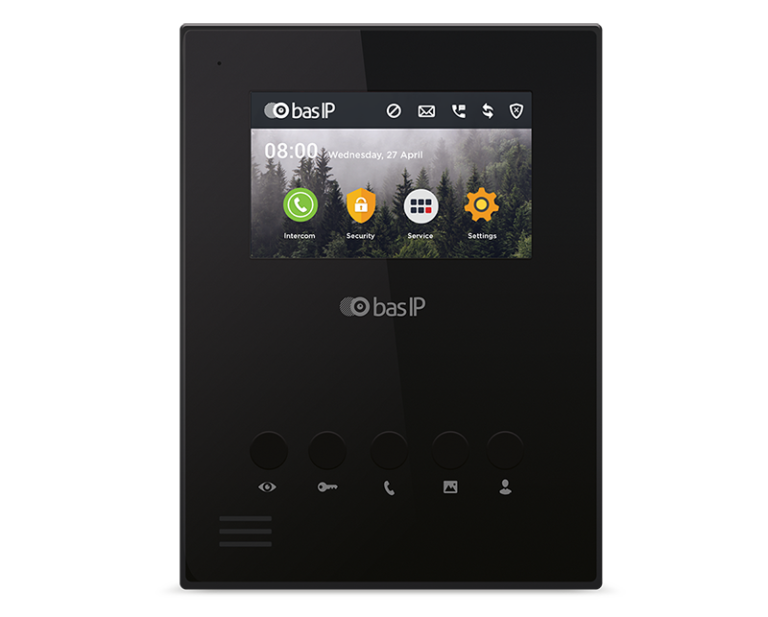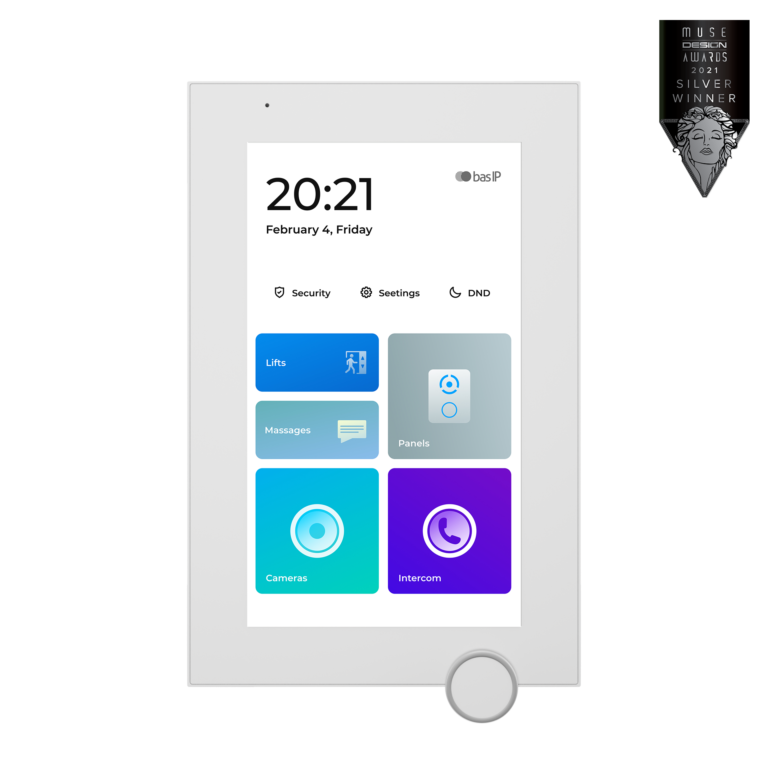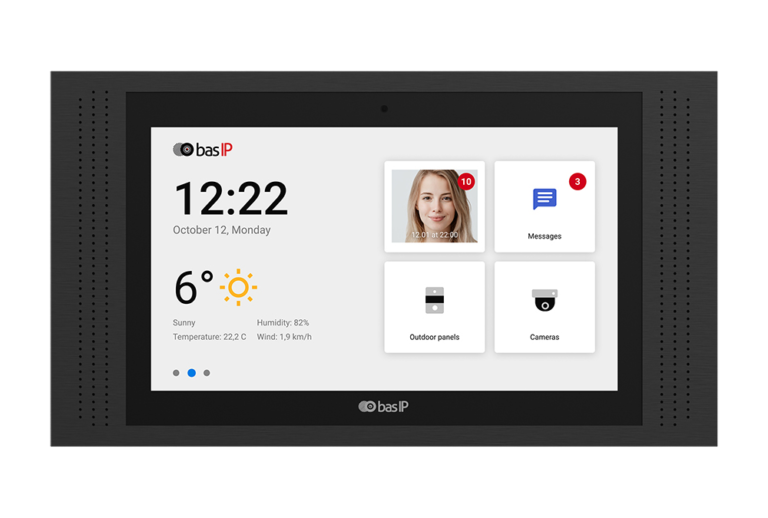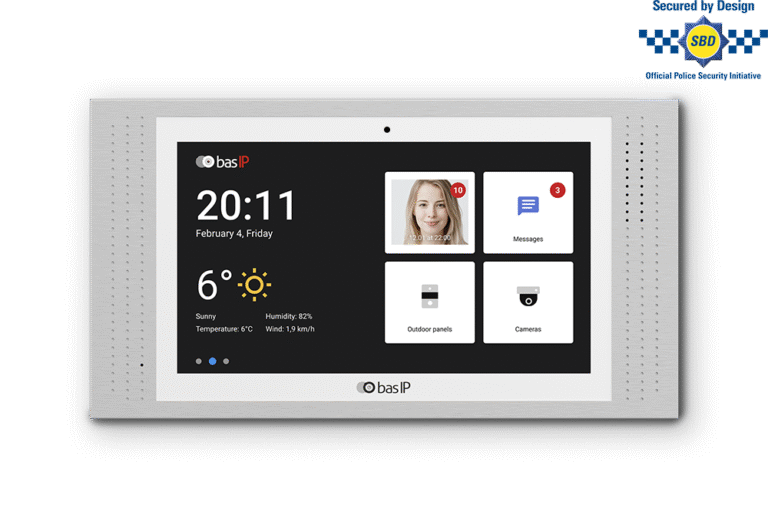Building Entry Systems: 2024’s Top Secure Picks Unveiled

As we step into 2024, the landscape of building security continues to evolve at an unprecedented pace. At the heart of this transformation lies the cornerstone of any secure property: building entry systems. Today, we’re not just talking about a means to enter and exit; it’s about how seamlessly technology can fortify security while simplifying access. This guide unpacks the latest innovations and top systems that are setting benchmarks in security and convenience for properties worldwide.
Table of Contents
The Evolution of Entry Systems
The odyssey of building entry systems from their mechanical origins to the digital age is a fascinating saga of technological ingenuity and integration. This journey, marked by continuous innovation, has led to the development of sophisticated systems that offer unparalleled security, convenience, and control. Let’s explore how features like built-in cameras, keyless entry, and cloud-based access management have revolutionized entry systems, transforming them into comprehensive security solutions.
The Rise of Digital Access: Beyond the Physical Key
The transformation began with the transition from physical keys to digital access, laying the groundwork for features like keyless entry and virtual keys (PIN codes) for visitors. This shift not only enhanced security by making it harder to duplicate access but also introduced a level of convenience previously unimaginable. QR codes for visitor access further streamlined entry for guests, eliminating the need for physical keys or access cards altogether.
Personalized Security: The Advent of Multifactor Authentication
As digital access methods became more prevalent, so too did the potential for security breaches. The response was the adoption of multifactor authentication, a system that combines two or more independent credentials: what the user knows (a password), what the user has (a security token), and what the user is (biometric verification). This layered approach significantly bolstered security, making unauthorized access exponentially more difficult.
Integrated Systems: The Heart of Modern Entry Solutions
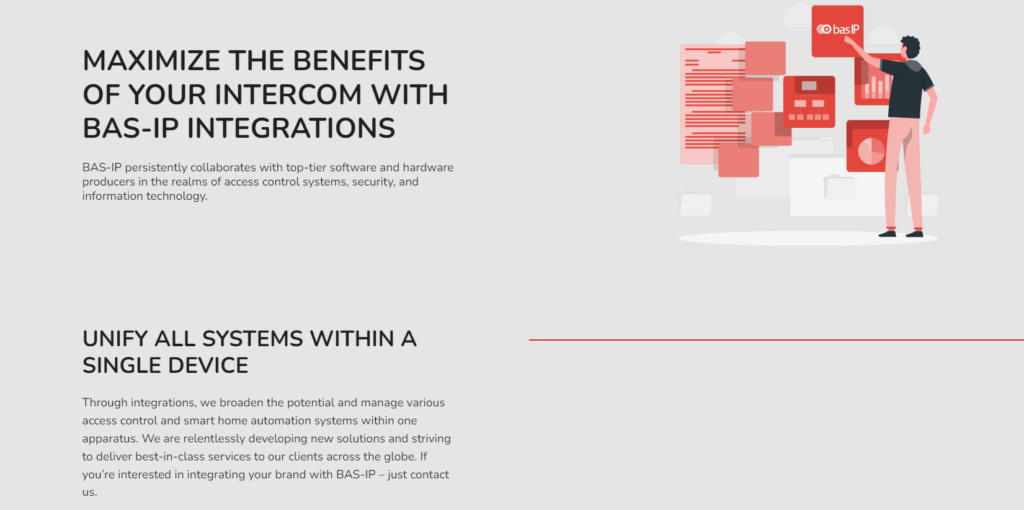
The true leap forward, however, came from the integration of entry systems with other technologies. Property management software integrations allowed for seamless control over access rights, integrating entry management with tenant information and facility services. Cloud-based access management took this a step further by enabling remote management of access points, ensuring that administrators could control and monitor entry from anywhere in the world.
Enhanced Surveillance and Control: Cameras and Connectivity
Built-in cameras and connected IP cameras integration introduced a visual component to entry management, allowing for real-time surveillance and historical access logs. This not only enhanced security but also provided valuable data for improving property management and safety protocols. Android-based monitors and 3rd party app support ensured that these systems could easily integrate with existing technology ecosystems, offering flexibility and scalability.
Comprehensive Access Solutions: From Temperature to Elevators
The scope of modern entry systems has expanded to include features like measuring temperature, an invaluable tool in the era of health consciousness, and elevator control, which streamlines access within multi-story buildings. The inclusion of visitor logs offers an audit trail of all entries and exits, a critical feature for security and compliance.
Mobile Integration: The Key to Convenience

Perhaps the most significant advancement has been the integration of entry systems with mobile apps, allowing users to control access directly from their smartphones. This has not only simplified the user experience but also provided a platform for integrating additional features, such as push notifications for entry alerts and the ability to grant or revoke access remotely.
Features That Define 2024’s Leading Systems
As we delve into the features that set apart the leading building entry systems in 2024, it’s clear that innovation, integration, and a keen focus on user convenience and security are at the forefront. Systems like BAS-IP, Comelit, Urmet Domus, 2N, Fermax, and Aiphone have pushed the boundaries of what entry systems can achieve, incorporating advanced technologies to meet the demands of modern users. Here’s how these features play a crucial role in defining the leading systems of 2024.
Seamless Integration and Advanced Security
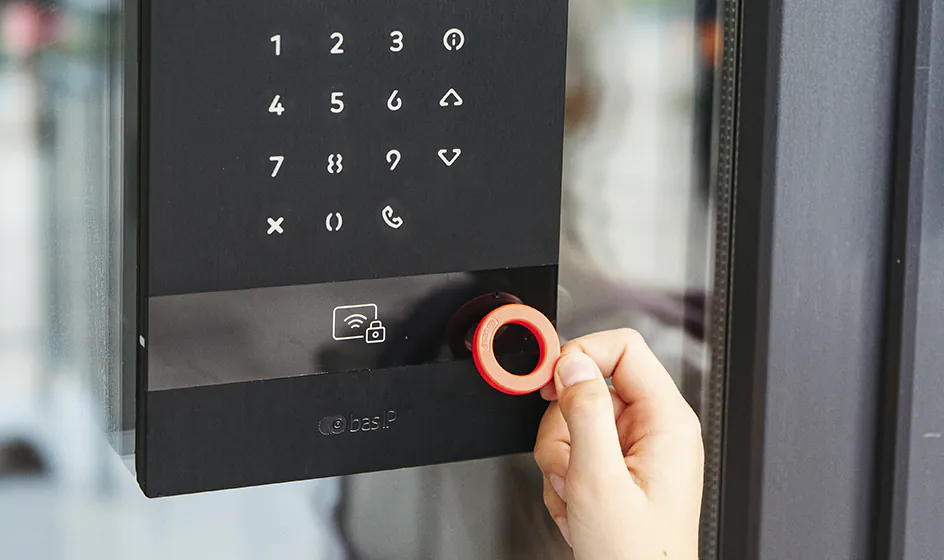
Built-in Camera
High-definition cameras have become a standard across leading brands, offering crisp visuals for identity verification and surveillance, enhancing security and peace of mind for residents and property managers alike.
Access Control
Technologies such as MIFARE, BLE (Bluetooth Low Energy), and NFC (Near Field Communication) are pivotal, with systems like BAS-IP and 2N offering a broader range of technologies for flexible, secure access.
Keyless Entry
The convenience of keyless entry is underscored by its adoption in several systems, with BAS-IP and 2N leading the pack, showcasing the industry’s move towards more user-friendly, secure entry solutions.
Convenience and User-Centric Features
Virtual Keys and QR Codes
BAS-IP and 2N excel by offering virtual keys and QR codes for visitor access, emphasizing ease of use and eliminating traditional physical keys or access cards, catering to a mobile-first generation.
Multifactor Authentication
A feature that significantly enhances security, offered by BAS-IP, 2N, and Fermax, ensures that access is granted only after verifying multiple credentials, making unauthorized entry exceedingly difficult.
Integration with Property Management and Cloud-Based Control
Property Management Software Integration
The ability to integrate with property management software, as seen with BAS-IP, Urmet Domus, 2N, and Fermax, signifies a trend towards centralized control and streamlined operations for property managers.
Cloud-Based Access Management
The shift towards cloud-based systems by BAS-IP and 2N highlights the industry’s focus on remote accessibility and management, offering flexibility and real-time control over access points.
Enhanced Functionality and Compatibility
Visitor Log and Temperature Measuring
Unique features like visitor logs, offered by BAS-IP, and temperature measuring capabilities signify the evolving role of entry systems in ensuring comprehensive security and health safety within premises.
Indoor Monitors and Android-Based Monitors
The range of indoor monitors, especially Android-based options by BAS-IP, 2N, and Fermax, illustrate the push towards integrating entry systems with smart home ecosystems, offering users intuitive and versatile interfaces.
Elevator Control and Third-Party Integration
- Elevator Control: This feature, available from several brands including BAS-IP, Comelit, and 2N, underscores the integrated approach to security, extending control beyond entry points to movement within buildings.
- Connected IP Cameras and Third-Party App Support: The integration with IP cameras and support for third-party apps, particularly by BAS-IP and 2N, demonstrates an open ecosystem approach, allowing for extensive customization and scalability.
Building Entry Systems Comparison
Here’s a concise comparison chart to visualize the distinct features and offerings of each system:
| Feature | BAS-IP | Comelit | Urmet Domus | 2N | Fermax | Aiphone |
|---|---|---|---|---|---|---|
| Build-in camera | Yes, HD | Yes, HD | Yes, HD | Yes, HD | Yes, HD | Yes, HD |
| Access control | MIFARE, BLE, NFC | MIFARE | MIFARE / HID | MIFARE, BLE | MIFARE | HID |
| Keyless entry | Yes | No | No | Yes | With external module | No |
| Virtual keys (PIN codes) for visitors | Yes | No | No | No | With external module | Yes |
| QR codes for visitor access | Yes | No | No | Yes | With external module | No |
| Multifactor authentication | Yes | No | No | Yes | Yes | No |
| Property management software integration | Yes | No | Yes | Yes | Yes | No |
| Visitor log | Yes | With external module | No | No | No | No |
| Measuring temperature | Yes | No | No | No | No | No |
| Cloud-based access management | Yes | No | No | Yes | Stand-alone | No |
| Indoor phones | Yes | Yes | No | Yes | 3rd party SIP devices | No |
| Indoor monitors | 7 models | 3 models | Yes | 3 models | 3 models | 3 models |
| Android based monitors | Yes | Yes (high price) | No | Yes | Yes | No |
| 3rd party app support | Yes | No | No | Yes | Yes | No |
| Mobile app | Yes | Yes | Yes | Yes | Yes | Yes |
| Elevator control | Yes | Yes | No | Yes | Yes | Yes |
| Connected IP cameras integration | Yes | Yes | No | Yes | Yes | No |
Why Upgrade to Advanced Systems?
Operational Efficiency through Integration
One of the most compelling arguments for upgrading to advanced systems is the significant boost in operational efficiency they offer. Integration with property management software allows for seamless control over access rights, streamlining administrative tasks and reducing the time spent on manual entry or access adjustments. Cloud-based management platforms enable administrators to modify access permissions in real-time from anywhere, eliminating the need for physical presence or traditional key exchanges. This level of efficiency not only saves time but also reduces the operational costs associated with managing a secure facility.
Convenience and User Experience
The user experience is markedly enhanced with the adoption of advanced entry systems. Features like keyless entry, mobile app access, and virtual keys for visitors prioritize convenience without compromising security. Residents and authorized users can enjoy smooth, hassle-free access, while property managers can easily issue or revoke access rights, accommodating temporary visitors or service personnel with minimal disruption. This balance of security and convenience reflects a deep understanding of modern lifestyle needs, where efficiency and ease of use are highly valued.
Data Insights and Management
Advanced entry systems are equipped with sophisticated analytics and reporting capabilities, offering valuable insights into access patterns and usage trends. This data can be instrumental in identifying operational inefficiencies, optimizing resource allocation, and even in enhancing tenant satisfaction by understanding and addressing their access needs. Additionally, features like visitor logs provide a detailed audit trail, enhancing security and facilitating compliance with regulatory requirements.
Future-Proofing Properties
Investing in advanced entry systems is a forward-looking decision that future-proofs properties against evolving security threats and technological advancements. These systems are designed with scalability and adaptability in mind, allowing for easy upgrades and integration with new technologies as they emerge. This not only ensures that properties remain at the cutting edge of security technology but also enhances their value and appeal in a competitive market.
Sustainability and Environmental Impact
Lastly, the shift towards advanced entry systems aligns with broader sustainability goals. By leveraging energy-efficient technologies, reducing waste associated with traditional keys and locks, and optimizing building access to better control heating, cooling, and lighting, these systems contribute to a more sustainable and environmentally friendly operational model.
Selecting Your Guardian for 2024
After analyzing the landscape of building entry systems for 2024, BAS-IP stands out for several compelling reasons:
- Comprehensive Security and Convenience: BAS-IP offers a blend of advanced security features like multifactor authentication, high-definition built-in cameras, and cloud-based access management. This ensures not just robust security but also unparalleled convenience for users and administrators alike.
- Wide Range of Access Control Options: With support for MIFARE, BLE, NFC, and more, BAS-IP provides a versatile range of access control technologies, catering to the diverse needs of modern properties.
- Innovative Features for Modern Lifestyles: Features such as temperature measuring, QR codes for visitor access, and virtual keys via mobile apps underscore BAS-IP’s commitment to meeting the evolving needs of today’s users.
- Seamless Integration and Scalability: The ability to integrate with property management software, along with support for Android-based monitors and third-party apps, makes BAS-IP a future-proof choice that can grow and adapt with your property.
- Reliability and Support: BAS-IP’s reputation for reliability, backed by comprehensive customer support and a clear focus on innovation, ensures that properties equipped with their systems are not just secure today but are also prepared for the future.
The Roadmap to Installation and Beyond
Installing an advanced entry system such as BAS-IP is a critical process that requires careful planning and execution to ensure optimal performance and security. Here’s a step-by-step how to install intercom guide, followed by key intercom maintenance strategies for the long haul.
Step-by-Step Installation Guide
- Planning and Design: Before any physical work begins, it’s essential to plan the system layout carefully. This includes determining the locations for devices like intercom panels, access control units, and any connected cameras or monitors. Consider the wiring routes and network infrastructure needed to support the system.
- Network Infrastructure: Ensure that the property’s network infrastructure can support the IP-based system. This might involve upgrading existing network components or installing new ones to handle the data traffic and ensure reliable communication between devices.
- Device Installation: Begin by installing the physical components of the system, including outdoor panels, indoor monitors, and any additional access control devices. Follow the manufacturer’s guidelines for mounting and securing these devices to ensure they are installed correctly and safely.
- Wiring and Connectivity: Connect the devices to the property’s network, paying careful attention to the wiring requirements. Use high-quality cables and connectors to reduce the risk of transmission losses or interference. Ensure that power supply requirements are met for all devices.
- System Configuration: Once all devices are connected, configure the system according to the specific needs of the property. This includes setting up access permissions, configuring call zones, and customizing any features like virtual keys or multifactor authentication settings.
- Testing and Troubleshooting: After configuration, thoroughly test the system to ensure all components are functioning correctly. Check the audio and video quality of intercom calls, test access control at various entry points, and verify that all integrations with other systems are working seamlessly.
Beyond Installation: Maintenance and Upkeep
- Regular Software Updates: Keep the system’s software up to date with the latest versions released by BAS-IP. Software updates often include security patches, feature enhancements, and performance improvements.
- Physical Inspections: Periodically inspect all physical components of the system for signs of wear or damage. Pay special attention to outdoor units that are exposed to weather conditions, ensuring they remain water-resistant and clear of debris.
- Cleaning Devices: Regularly clean device screens, cameras, and sensors to ensure clear audio and video transmission. Use appropriate cleaning materials to avoid damaging sensitive components.
- Network Health Checks: Monitor the health of the network supporting the BAS-IP system. This includes checking for any issues with routers, switches, and other network hardware that could impact system performance.
- Backup and Data Protection: Implement regular backup procedures for the system’s configuration and access logs. This ensures that you can quickly restore the system in the event of a failure or data loss.
- Professional Maintenance: Consider scheduling annual or semi-annual maintenance checks with a certified BAS-IP technician. Professional maintenance can help identify potential issues before they become serious problems, ensuring the longevity and reliability of the system.
Peering into the Future
The evolution of building entry systems is accelerating, driven by rapid technological advancements and changing societal needs. The integration of artificial intelligence (AI), Internet of Things (IoT) connectivity, and blockchain technology is not just reshaping the landscape of access control but also redefining our expectations of security, convenience, and efficiency. Let’s delve into how these innovations are set to transform building entry systems in the near future.
Artificial Intelligence and Machine Learning
AI and machine learning are poised to bring unprecedented intelligence to building entry systems. These technologies enable systems to learn from access patterns, identify anomalies, and even predict potential security breaches before they occur. Imagine an entry system that recognizes a resident’s behavior and automatically adjusts access controls based on their routines, or one that detects unusual activity and alerts security personnel in real-time. AI can also enhance the capabilities of facial recognition technologies, making them more accurate and capable of identifying individuals even under varying conditions.
Internet of Things (IoT) Integration
The IoT revolution has already begun to make its mark on building entry systems, and its impact is only set to grow. By integrating entry systems with other IoT-enabled devices within a property, such as lighting, climate control, and surveillance cameras, we can create a more cohesive and intelligent ecosystem. This integration allows for scenarios where entering a building can trigger personalized settings for lighting and temperature, enhancing energy efficiency and user comfort. Moreover, IoT connectivity facilitates remote management and monitoring of access points, providing administrators with unparalleled control and insight.
Blockchain for Enhanced Security and Privacy
Blockchain technology offers a novel approach to securing building entry systems. By decentralizing access control data, blockchain can create a tamper-proof record of all entry and exit transactions. This not only enhances security by making it virtually impossible to alter access logs but also improves privacy by giving individuals control over their data. In the future, blockchain could enable secure, anonymous authentication methods that protect users’ identities while ensuring only authorized access.
Sustainable and Energy-Efficient Solutions
Sustainability is becoming a priority in every industry, including building security. Future entry systems will likely emphasize energy efficiency, both in the operation of the systems themselves and in their ability to contribute to the broader energy efficiency of the buildings they secure. For instance, entry systems could integrate with smart grids to optimize energy use throughout the property, or use solar power to reduce their environmental footprint.
User-Centric Design and Customization
As technology advances, so too does the importance of user experience. Future building entry systems will prioritize not just security and efficiency but also ease of use and personalization. Systems will become more intuitive, with user interfaces that can be customized to meet the specific needs and preferences of individual users. Additionally, we can expect to see more adaptive systems that automatically adjust security levels based on real-time risk assessments, providing a seamless experience for users without compromising on security.
Conclusion
As we navigate the complexities of modern security and access control, the advancements in building entry systems stand as a testament to the incredible strides made in technology and user experience design. The journey from mechanical locks to sophisticated, interconnected systems reflects a broader trend towards creating spaces that are not only secure but also intelligent, efficient, and adaptable to the needs of their users.
The exploration of 2024’s leading systems, including the standout features of BAS-IP, underscores a pivotal shift in how we approach property security. It’s clear that the future lies in leveraging advanced technologies—such as AI, IoT, blockchain, and more—to forge systems that offer unparalleled security, convenience, and flexibility. These systems are no longer mere gatekeepers; they are integral components of a smart, sustainable infrastructure, enhancing the way we live and interact with our environments.
The roadmap to installation and beyond highlights the importance of not just choosing the right system but also ensuring its longevity through proper maintenance and upgrades. As we look towards the horizon, the potential for future innovations in building entry systems is boundless. The integration of AI and machine learning promises systems that are not only reactive but predictive, offering security measures that anticipate and neutralize threats before they manifest. IoT connectivity heralds a new era of seamless integration, where entry systems communicate with a network of devices to create a cohesive, responsive environment.
In conclusion, the evolution of building entry systems is a mirror reflecting our advancing society’s priorities: security, convenience, sustainability, and the seamless integration of technology into our daily lives. As we embrace these innovations, we not only enhance the security and functionality of our properties but also contribute to the creation of smarter, more sustainable communities. The future of building entry systems is not just about opening doors; it’s about opening new possibilities for safety, efficiency, and connectivity in the spaces we inhabit. The key to this future is in our hands, ready to unlock the potential of the next generation of access control.

